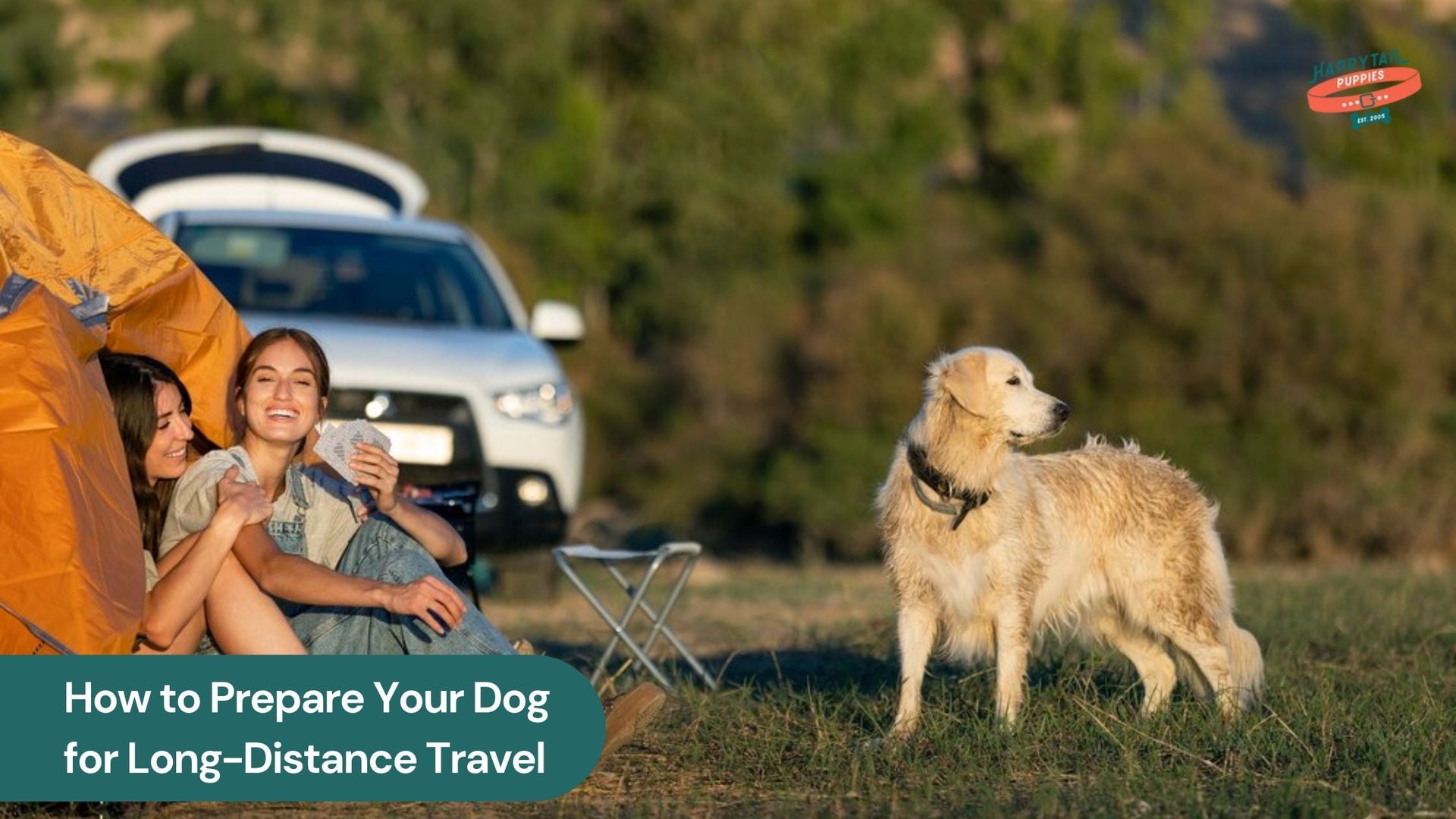Preparing Your Dog for Long-Distance Travel: A Step-by-Step Guide
Traveling with your dog can be a rewarding experience, but it requires thoughtful preparation. Learn how to plan ahead, choose the right gear, and implement strategies to keep your furry friend safe and comfortable on long journeys.
Life is full of wonderful moments, and one of the best is traveling. Going on a trip can bring lots of joy, especially when your pet dog is right there with you. However, traveling long distances with a dog takes more than just packing a crate, a leash, or some treats. It's important to make a solid plan, prepare everything needed, and think of creative ideas on how to travel long distances with a dog safely. This way, both you and your furry friend can have a great experience together.
Why Early Preparation is Crucial for Your Dog’s Comfort
Early preparation can help your dog adjust in great comfort, especially for long-distance travel, as it helps you gradually introduce your pup to the new set of experiences. Recognizing the issues, such as motion sickness or anxiety, sooner can help keep your pet in great comfort, filled with confidence and readiness as the travel day arrives.
- Build Familiarity: Slowly introduce your pup to short car rides and travel gear to help them stay more comfortable and reduce stress, especially on the actual day of the journey.
- Health and Safety Checks: Early visits to the vet ensure on-time vaccinations, which allow for the identification of health concerns and the securement of important documentation without any undue stress.
- Reduce Anxiety: Recognizing the signs of travel anxiety sooner gives sufficient time to explore calming strategies and practice them effectively.
- Test Feeding Routines: Finding out the feeding schedules and routines sooner ensures that your pup's digestive system adapts, ideally, preventing any stomach upset or discomfort during the longer trip ahead.
- Emergency Planning: Prepare an emergency kit and identify veterinary services sooner to ensure a prompt response and better peace of mind throughout your travels.
Let the Adventure Begin!
While the excitement enriches the air and tails start to wag, it is the ideal time to follow on to these expert-led steps to create an unforgettable long-distance trip with your pup.
Step 1: Vet Visit Essentials
Once you have decided on making your travel plan, having some more considerations in line proves effective, mainly when you have your dog travel with you. Furthermore, confirming everything regarding vaccinations and ensuring that they are updated with the latest vaccines is a prerequisite aspect one has to consider. Also, ensure to get the health certifications across the state or the national border. The breeds that are prone to a few specific health concerns, the Maltese puppies, might require special dental care, as this checkup is extremely critical. Also, ensure that your vet offers travel-related advice on handling any motion or anxiety sickness in the best way.
You must see to it that your pet’s health is in check. Also, the US Department of Agriculture reports that you do well to put in touch with a USDA-accredited vet beforehand, which in turn will issue the required health clearances. Also, you will be made aware of import requirements at your destination. This proactive step will, in large part, prevent any travel delays and also see to it that you are in full compliance with international regulations.
Step 2: Perfecting Your Travel Gear
Choosing the appropriate gear can impact the overall comfort of your dog during travel. Also invest in secure or spacious crates or a reliable seat belt harness system designed specifically for the pups. Line the crate with comfortable bedding by adding your pup's favorite toys, offering better familiarity. Furthermore, the portable travel bowls, waste disposable bags, grooming wipes, or the basic first aid items, which are one of the important dog travel tips, ensure better comfort and convenience on the road.
Step 3: Short Journeys to Long-Term Success
Making your dogs adjust to the travel conditions sooner greatly boosts the travel experience. You can start by taking a shorter route to the practice trips around the town while eventually increasing the travel times. Rewarding their good behavior with treats and love can help create positive associations with traveling. It is mainly effective for sensitive small dog breeds like Cavalier King Charles Spaniels, who thrive considerably on love and encouragement.
Step 4: Feeding Strategies to Avoid Upsets
Timing your pup's meals accurately can help prevent digestive discomfort while travelling. Avoid feeding them heavier meals right before departure; also, feed them lighter meals around three hours before heading out for the trip. Also, offer them water consistently in moderate quantities during the entire journey. Follow their regular diet to avoid any gastrointestinal issues.
Step 5: Frequent Stops for Exercise and Relief
Strategic breaks are compulsory when you take your dog along on your travels. Plan to stop for about two to three hours, which helps your furry companion explore, stretch, and relieve itself. Choose rest areas with grassy parks and even spaces. During these breaks, ensure to engage your pup in playful activities ideal for small dog breeds like the Maltese with a high level of energy, which need frequent, manageable exercise intervals.
Step 6: Keeping Your Dog Entertained
Preventing any boredom, especially during the lengthy travel, is important. Also, ensure to bring along the puzzle feeders, interactive toys, and the best chew toys. The items encouraging mental stimulation can help maintain a content and calm dog. Ensure that the toys are easy to handle, especially across the confined travel spaces. It is the best kind of entertainment strategy, ensuring to keep your pup content, happy, and less anxious on the journey.
Step 7: Reducing Anxiety Creatively
Anxiety related to travel impacts even the experienced canine traveler. Also, employ natural soothing methods using anxiety wraps, pheromone sprays, or calming herbal supplements. Familiar household items, like the favorite blanket, can help reduce stress. Soft background music or gentle ambient sounds offer a soothing ambience, which is especially effective for sensitive small dog breeds like Cavalier King Charles Spaniels, which are considered mainly for their emotional awareness.
Step 8: Air Travel Tips for Dogs
When your adventure includes trips by flight, it is important to make intricate preparations. Air travel has its own set of complexities. It is important to follow airline regulations closely related to the dimensions of the carrier and the pet documentation. The pet owners should also make sure that their furry companions have their identification tags and updated microchip details. One of the ideal air travel tips for dogs is to keep pups hydrated throughout the journey and also feed them right before entering the plane. This can prove effective in reducing stress or any sort of discomfort.
The Centers for Disease Control and Prevention (CDC) focuses on the real essence behind securing your pup in the right level of carrier, labeling it clearly to ensure that your pet has proper access to water. Such measures can help protect your pup's well-being while on flights.
Step 9: Accommodations that Welcome Your Pet
It is important to pick a dog-friendly accommodation, as it can help boost your overall experience. Also, verify the hotel or rental policies that are closely related to dogs. Search for amenities such as pet exercise areas, dedicated pet-walking trails, and ease of access to outdoor spaces. Upon arrival, it is important to ensure that you have your pet supervised during the initial exploration, easing their transition across the new space. The accommodations can help understand and welcome pets, making traveling enjoyable and effortless.
Step 10: Weather Awareness and Safety
The weather can really affect how your dog feels. It's important to keep your car at the right temperature with good airflow. In hot weather, think about using cooling mats, portable fans, or sunshades to keep your dog cool. In cold weather, use warm blankets or specially made dog sweaters. Always keep an eye on your dog and make changes quickly if needed to keep them comfy. This helps avoid problems from extreme temperatures.
Step 11: Emergency Preparedness
No matter how well you prepare, the unexpected will happen. Put together an emergency kit that includes information on vet care, pet ID tags, and basic first aid supplies. Also, have your dog microchipped, which is very easy, in case you get separated. Check out the local vets along your route and in the areas you will be visiting.
This will help you handle emergencies calmly and preparedly. It is very important to be prepared for emergencies when traveling with your pet. Studies found that it is best to keep your pet on a leash, which in turn will prevent them from getting sick or injured. Put into practice safety measures that will protect your pet from illness or injury. Also, have a plan in place for health issues that may arise, including having at hand veterinary contact info for your destination.
Step 12: Maintaining Hydration and Nutrition
When out with your dog, it is very important that you see to their health and wellness. At all times, have fresh water available for your dog, and also give them a little water often to prevent dehydration. Also, pack some healthy treats or full meals that will appeal to your dog. Go for options that are easy to digest and which won’t cause them distress. By feeding your dog well and keeping them hydrated, you will do what it takes for them to have energy and feel at ease, making the trip a positive and pleasant one for them.
Step 13: Post-Travel Adjustment Time
Once you’ve arrived at the destination, your dog will need time to adjust and unwind. Ensure a lot of rest, limit first excitement, and make way for travel stress reduction. Permit free exploration in a careful manner of new locations so that they will become accustomed gradually. Continued feeding, movement, and rest time routines will provide a sense of security and comfort. This approach to thinking ensures that your pet is well adapted rapidly, all in all, making best friends with the new environment without unnecessary strain or anxiety.
Step 14: Establishing Safe Spaces
Establishing safe spaces in your journey mode and upon arrival at your destination considerably eases stress in your dog and provides comfort. Make one’s bed with favorite bedding or blankets and add their favorite toys to recreate a comfortable environment. Definite spaces provide a sense of security, so strange places are not so scary. Providing your dog with a consistent place to lodge will reinforce emotional balance and relaxation necessary for extended travel or a visit away from home.
Step 15: Monitor Behavior and Health Regularly
Monitoring your dog’s behavior and health while on a trip must be on a constant basis. Look out for indications of discomfort, stress, or ill health; excessive panting, restlessness, or a loss of appetite. Early detection of unusual behaviors will enable you to pick up and tweak your travel plan accordingly as soon as possible. Follow-ups on their health and state of mind have a lot to add to your dog’s overall happiness, comfort, and safety during the trip.
Conclusion
Voyaging far distances and your dog is way more than a logistics problem. It’s an opportunity to develop deeper connections and unforgettable memories. Every mile with your loved one closes your connection and makes you joyful and knowledgeable comrades on your quest. Just by planning carefully, by considering what your dog needs exactly, and finding a creative solution for each trip, you create a fun page in your dog’s life. Knowing precisely how to travel long distances with a dog is the difference between every adventure becoming a cherished memory filled with wagging tails and playful leaps, and an ocean of discovery.


